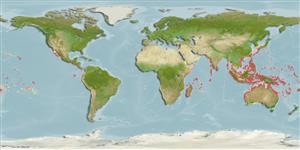Common names from other countries
>
Perciformes/Scorpaenoidei (Scorpionfishes) >
Scorpaenidae (Scorpionfishes or rockfishes) > Scorpaeninae
Etymology: Parascorpaena: Greek, para = near, in the side + Latin, scorpaena = a kind of fish, 1706 (Ref. 45335).
More on author: Peters.
Issue
Distribution of this species probably include those referring to Parascorpaena armata. Please send references.
Environment: milieu / climate zone / depth range / distribution range
Ekologi
marina revassocierade; djupintervall 0 - 18 m (Ref. 9710). Tropical
Indo-Pacific: East Africa to the Society Islands, north to Izu Islands, south to Australia; throughout Micronesia (Ref. 1602). Specimens from the Pacific Ocean, currently
regarded as P. mossambica, are most likely to be P. armata (H. Motomura, unpubl. data). The name, P. mossambica., remains valid for specimens from the Indian Ocean (Ref. 86966).
Size / Vikt / Age
Maturity: Lm ? range ? - ? cm
Max length : 12.0 cm TL hane/ej könsbestämd; (Ref. 90102)
Taggstrålar i ryggfenan (totalt) : 12; Mjukstrålar i ryggfenan (totalt) : 9; Taggstrålar i analfenan: 3; Mjukstrålar i analfenan: 5. Supraocular tentacles well developed (Ref. 37816, 48635).
Inhabits areas with mixed sand and rubble in reef flats, shallow lagoons, and channels. Hides during the day, ventures out in the open at night. Anterolateral glandular groove with venom gland (Ref. 57406). Solitary (Ref 90102).
Life cycle and mating behavior
Maturities | Reproduktion | Spawnings | Egg(s) | Fecundities | Larver
Myers, R.F., 1991. Micronesian reef fishes. Second Ed. Coral Graphics, Barrigada, Guam. 298 p. (Ref. 1602)
IUCN Red List Status (Ref. 130435)
CITES (Ref. 128078)
Not Evaluated
Human uses
Verktyg
Special reports
Download XML
Internet-källor
Estimates based on models
Preferred temperature (Ref.
115969): 24.3 - 29.3, mean 28.4 (based on 2873 cells).
Phylogenetic diversity index (Ref.
82804): PD
50 = 0.5078 [Uniqueness, from 0.5 = low to 2.0 = high].
Bayesian length-weight: a=0.01259 (0.00606 - 0.02615), b=3.03 (2.86 - 3.20), in cm Total Length, based on LWR estimates for this (Sub)family-body shape (Ref.
93245).
Trofisk nivå (Ref.
69278): 3.6 ±0.4 se; based on size and trophs of closest relatives
Resiliens (Ref.
120179): Hög, lägsta populationsfördubblingstid mindre än 15 månader (Preliminary K or Fecundity.).
Fishing Vulnerability (Ref.
59153): Low vulnerability (10 of 100).
